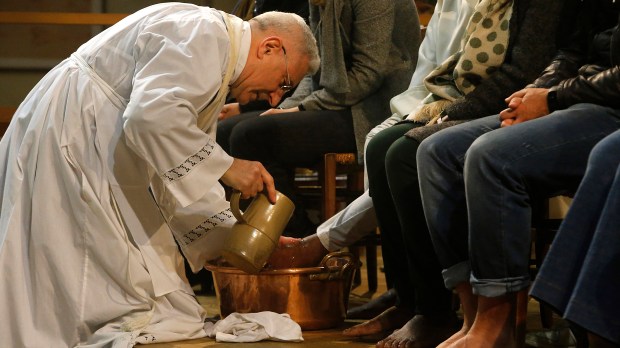Lenten Campaign 2025
This content is free of charge, as are all our articles.
Support us with a donation that is tax-deductible and enable us to continue to reach millions of readers.
One of the signature parts of the liturgy during Holy Week is the traditional feet washing on Holy Thursday. During the middle of Mass, priests will wash the feet of parishioners, imitating the example of Jesus at the Last Supper.
The act of washing feet during the liturgy is very ancient and initially was not reserved to Holy Thursday.
Dom Prosper Gueranger explains in his Liturgical Year how it began in the early Church.
At the commencement it was almost a daily practice. St. Paul when mentioning the qualities which should adorn the Christian Widow, includes that washing the feet of the Saints, that is of the Faithful. We find this act of humble charity practiced in the Ages of Persecution and even later. The Acts of the Saints of the first six centuries and the Homilies and Writings of the Holy Fathers are filled with allusions to it.
St. Augustine mentions it in a letter to Januarius.
As to the feet-washing, since the Lord recommended this because of its being an example of that humility which He came to teach, as He Himself afterwards explained, the question has arisen at what time it is best, by literal performance of this work, to give public instruction in the important duty which it illustrates, and this time [of Lent] was suggested in order that the lesson taught by it might make a deeper and more serious impression
By the Middle Ages the act of feet washing became a part of the liturgical celebration of Holy Thursday, where local bishops and even the pope would wash the feet of12 poor persons.
This was later refined and limited at the Vatican to 12 deacons, priests, or bishops. In turn, it was stated in the Roman Missal in 1955 that 12 men were to be chosen for this ceremonial feet washing on Holy Thursday, representing the 12 Apostles.
Then in 2016, Cardinal Sarah, the prefect of the Congregation for Divine Worship and Discipline of the Sacraments at the time, issued a letter permitting the washing of women’s feet on Holy Thursday.
This change was meant to allow “pastors [to] choose a group of faithful representing the variety and unity of every part of the People of God. This group may consist of men and women, and ideally of the young and the old, healthy and sick, clerics, consecrated persons and laypeople.”
The ceremony remains a beautiful part of Holy Thursday, reminding us that discipleship requires of us an imitation of Jesus Christ, who gave his life for us and showed us how to love one another.

